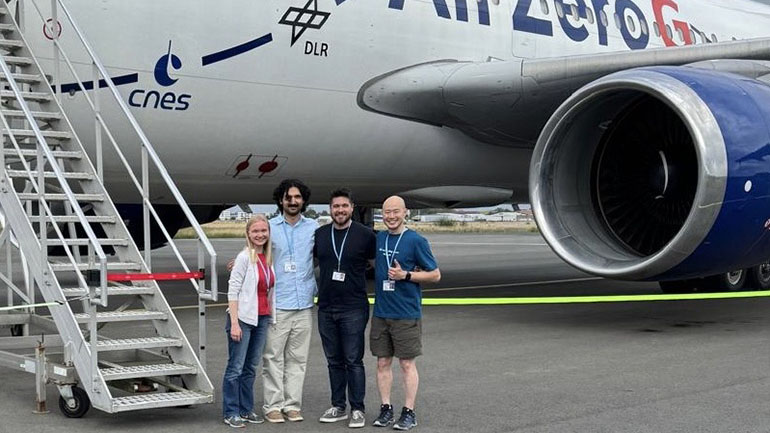
A research team conducted experiments in France that could shape future medical protocols for astronauts and patients on Earth.
Photo: Dr. Siobhan Wagner, Adrian Tabari, Dr. Matthew Turnock and Dr. Alex Suen
Growing up, Matthew Turnock dreamed of becoming an astronaut. While attending a lecture featuring retired Canadian Space Agency astronaut and emergency physician Dr. Dave Williams, he realized that you don’t need to be an engineer or a pilot to go to space—you can also be a doctor.
In September 2025, Dr. Turnock, now an anesthesiologist at Royal Columbian Hospital, came a little closer to fulfilling his childhood dream by experiencing microgravity for the first time while in France.
WATCH: Researching how anesthetic behaves in space
“It was very intense, like you’re falling off a rollercoaster,” says Dr. Turnock.
Their lab was the world’s largest gravity-free aircraft—the Airbus A310 Zero G.
“It felt like the plane was careening to the surface of the earth, because your brain doesn't know up from down in microgravity.”
Supported by the European Space Agency, the Canadian Space Agency, and an innovation grant established by Royal Columbian Hospital anesthesiologists, Dr. Turnock along with Dr. Alex Suen, anesthesiologist, Dr. Siobhan Wagner, anesthesiologist resident, and Adrian Tabari, UBC medical student, conducted experiments on how anesthetic drugs behave in microgravity. Their findings may also improve our understanding of how these drugs work in patients on Earth.
“I had heard many accounts of weightlessness before, but nothing quite prepares you for experiencing it yourself. When the aircraft experiences 1.8 g, every part of your body feels twice as heavy. Then, virtually instantaneously, you feel no gravity at all, and every limb is suddenly floating in the air,” says Dr. Turnock.
As the plane arced, climbed and fell to create periods of weightlessness (known as parabolas), the research team injected a 3D-printed model of the spinal canal with anesthetic drugs.
On earth, general anesthetic medication is often delivered via inhaled gases. In space, that method is not an option because if any gas leaks into the cabin, it could anesthetize the entire crew.
“For space travel we must look at other ways of providing anesthetics, either injection anesthetics or through spinal anesthesia,” explains Dr. Turnock. “Without gravity to guide the medication, we need to know that the drugs won’t float up to the brain and affect the heart and breathing, potentially causing unconsciousness.”
Their flights over France confirmed that anesthesia likely travels through the spinal canal in microgravity similarly to how it travels on Earth.
“Regardless of the density of the medication, it didn’t float. If anything, it spread slower, so we may need more medication or perhaps we need to inject it faster or slower in space,” Dr. Turnock says.
As is often the case with research, each discovery opens the door to new frontiers.
“The holy grail would be to fly a model to the International Space Station and see how anesthesia behaves in space,” says Dr. Turnock.
With space missions stretching longer and more people venturing beyond our atmosphere, Dr. Turnock’s childhood dream of becoming an astronaut might not be so far out of this world after all.
